Days on the Water: 0
Who we fished with: n/a
Where we fished: n/a
What we caught: n/a
Tactics: n/a
Commentary
Observations from the Water – this Past Week (8-14 Feb)
It’s been 2 weeks in a row that we’ve experienced zero days above freezing here in Buffalo Niagara, NY. Those frigid temperatures were partly to blame for our lack of fishing this this past week, but it wasn’t the main reason we were off the water. A new factor emerged from the frigidity…well…new for this year but by no means an anomaly. Before discussing this new addition to the challenges of winter fishing in 2021, I have to set the scene a bit.
Winter Angling – Go/No-go Criteria
As I’ve mentioned a few times now, air temperature is a factor this time of year, but I don’t think it’s the main factor when considering whether or not to go fishing. Air temperature mostly effects the angler’s experience – i.e. can you stay warm enough to stay engaged and make things work. It also effects efficacy of equipment (i.e. reels freeze, ice forms in the guides, nets freeze, etc.), but not so much so that it effects the action. Besides, if it’s sunny, most of these points of friction melt away.
Here in Buffalo Niagara, NY, wind and water clarity are the factors that have the largest impact an angler’s ability to pursue our quarry. Wind is a huge consideration because if effects the angler’s ability to present the bait – think drift/current speed/wave action. Clarity is also important because it effects fish behavior (is the water clear enough for the fish to see the bait?). On most days/during the overwhelming majority of the year, these 2 factors dictate the “fishability” of our waters. However, there is a unique consideration in the winter that relates to air temperature – ice. Specifically, ice coverage on the Great Lakes and in the Niagara River.
Ice coverage can be the main concern of the winter angler here in Buffalo Niagara…if it comes to pass. The annual % of max ice coverage on Lake Erie is important for a few reasons that I’ll try to describe in simple formulas/causal relationships:
1. more ice = less water exposed to the air
2. less water exposed to the air = less water available to generate lake effect snow
3. less water exposed to the air = less wave action
4. less wave action = higher clarity of water
5. higher clarity of water = better catch rates…until it stays clear for a prolonged period – then it slows down
Note – the ice in the middle of the great lakes isn’t solid. It’s more like a conglomerate of various sized icebergs – big blocks of ice all mashed together. A strong enough wind will push on the ice, break it up and send it downstream/in the direction of the wind. When that happens, the river will fill up with ice making it unnavigable for a couple days. This is what happened this past week.
Expressed a little differently:
1. more ice = later thaw
2. later thaw = longer wait for water to heat up
3. longer wait for water to heat up = longer wait for bait to concentrate = longer wait for the spring feed!
4. longer wait for water to heat up = longer wait for spring spawning fish to begin spawning
Recent Case Study
In 2020, max ice coverage on Lake Erie was 20% (see here for details). However, last year was NOT the norm, as you’ll notice if you visit that link. In other words, if your pursuit of everything that swims in 2021 is based on the pattern/timing you saw unfold in 2020, you’ll likely end up disappointed.
I spent a couple hours this past week overlaying catch rates from my logbook onto historical water temperatures of Lake Erie/the Niagara River and made some interesting findings that I’ll publish in a later blog. This is for sure straight geekery and superfluous research BUT I went down this rabbit hole because I had to remind myself of the timing of “normal, seasonal patterns.” Hopefully that bit of research will help to predict when action might tick up in 2021 for the other half of the fish in our pursuit portfolio. So yeah, I dig deep when I’m not on the water. The reality is, although this was an interesting excerise and I learned a lot, nothing replaces time on the water and realtime intelligence.
Research Tools
I understand that much of the information listed above isn’t “news” to experienced anglers around here. Sure, all of us anglers observe certain “rules of thumb” or make mental notes of patterns we can use in the pursuit our quarry. Still, how often do we think about why those rules work or why those patterns emerge? I’m betting not that often.
One of the things that makes the Buffalo Niagara, NY fishery so engaging is that it’s somewhat easy and endless fascinating to observe how integrated the ecosystem is. What happens in one part directly affects the other. Again, I get it that this isn’t “news” for us anglers – but many folks reading this aren’t anglers…or are budding anglers at best. Furthermore, few if any of the folks reading this are aware that everything described above is taking place right outside their window. I hope to increase that awareness a little bit so we can all appreciate and protect these amazing resources.
If you are inclined (like me) to “geek out” on data or just want to learn more, here are some resources:
Ice Cover: NOAA Great Lakes Environmental Research Laboratory – data showing historical ice coverage of all the great lakes. If you dive into the last 5 years of data, you’ll notice the 2020-2021 season is very similar to the 2018-2019 season. In short, Lake Erie froze over during the same period (end of Jan into beginning of Feb). During this period, ice coverage went from the low teens to over 80%…it’s amazing how quickly that can happen.
Niagara Falls Live Webcam Feed – provides a bird’s eye view of the horseshoe falls. More importantly for the angler, it shows how much ice is at the base of the falls – sometimes a good marker to determine if the lower Niagara is navigable.
The 2 tools above are helpful/a decent starting position if you’re trying to decide whether or not to leave the house to fish. However, ice flows down the Niagara are far more important in making that call because big if there are a ton of icebergs flowing downriver, you ain’t fishing. Still, just because it’s iced up below the falls and Lake Erie is covered with ice, doesn’t mean ice is flowing down river. See the notes below to understand what happens sometimes and why. Bottom line, nothing replaces “eyes on” reconnaissance.
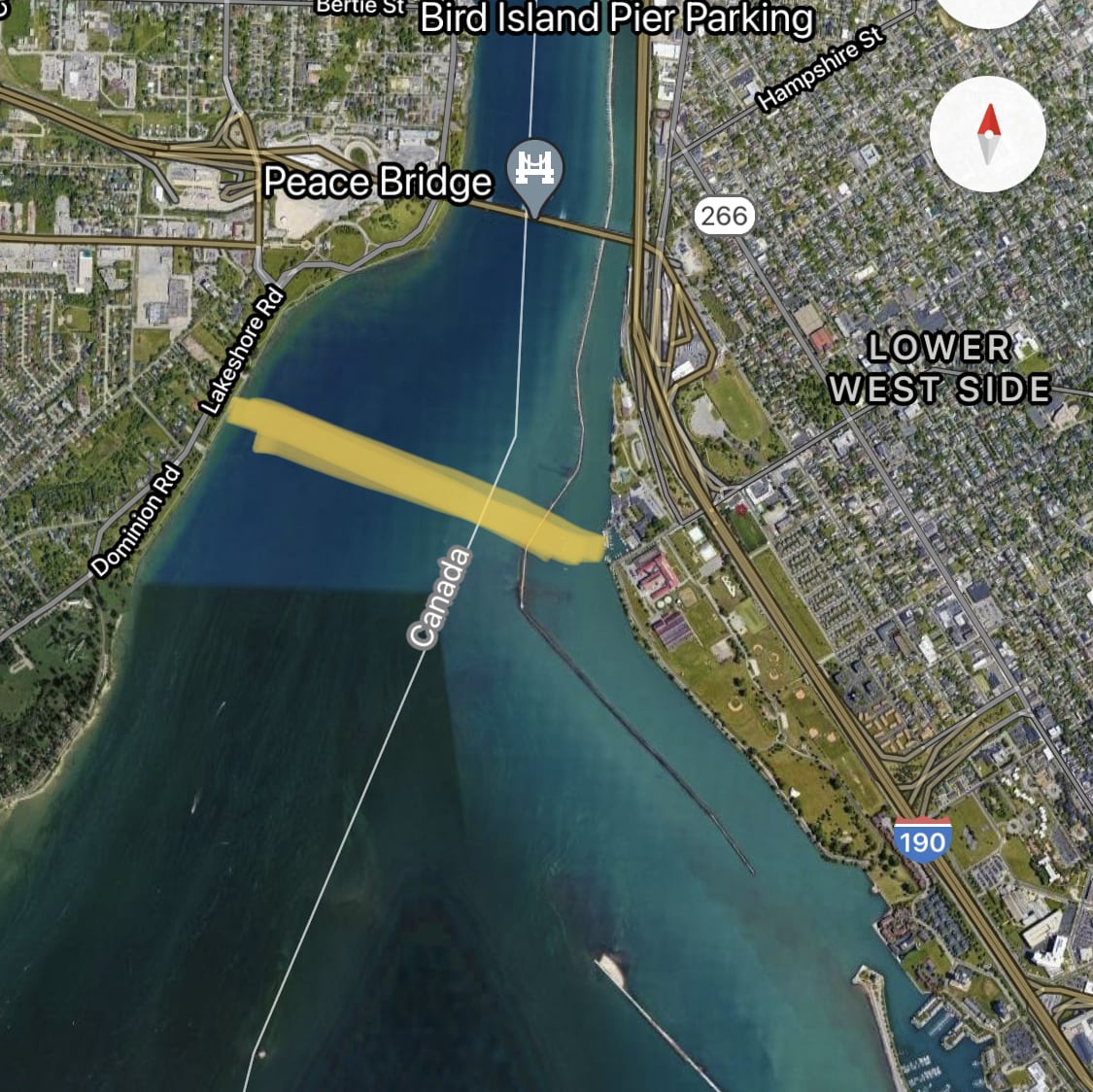 The yellow line highlighted on this image is the approximate location of the Lake Erie ice boom – a series of large buoys put in place during the winter to prevent ice flows from Lake Erie into the Niagara River. On most days, this thing does what it was designed to do
The yellow line highlighted on this image is the approximate location of the Lake Erie ice boom – a series of large buoys put in place during the winter to prevent ice flows from Lake Erie into the Niagara River. On most days, this thing does what it was designed to do
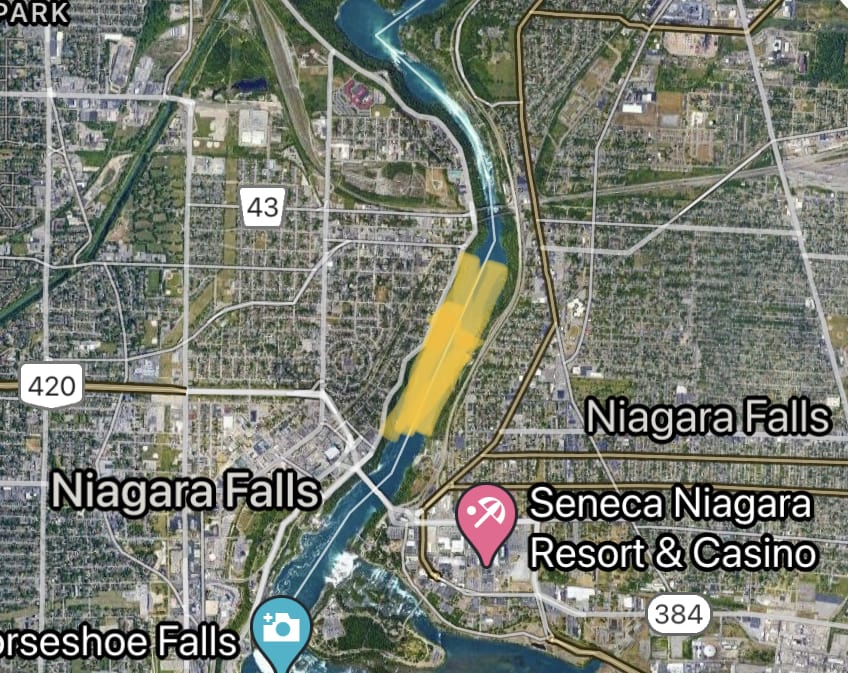 The run downstream of Niagara Falls – this is one of the narrowest parts of the Niagara River. When ice goes over the falls in massive quantities, it often collects here and forms an “ice bridge” or damn. This ice bridge often prevents the flow of ice downstream, leaving much of the lower Niagara navigable even though there is a lot of ice in the system. There isn’t an ice bridge built up…yet.
The run downstream of Niagara Falls – this is one of the narrowest parts of the Niagara River. When ice goes over the falls in massive quantities, it often collects here and forms an “ice bridge” or damn. This ice bridge often prevents the flow of ice downstream, leaving much of the lower Niagara navigable even though there is a lot of ice in the system. There isn’t an ice bridge built up…yet.
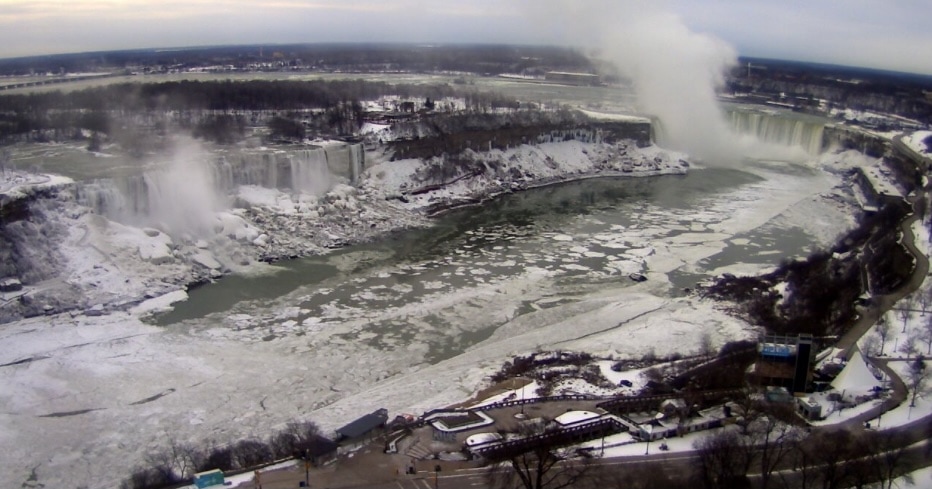
View of Niagara Falls via webcam from Niagara Falls, ON. Provides a decent view of ice build up.
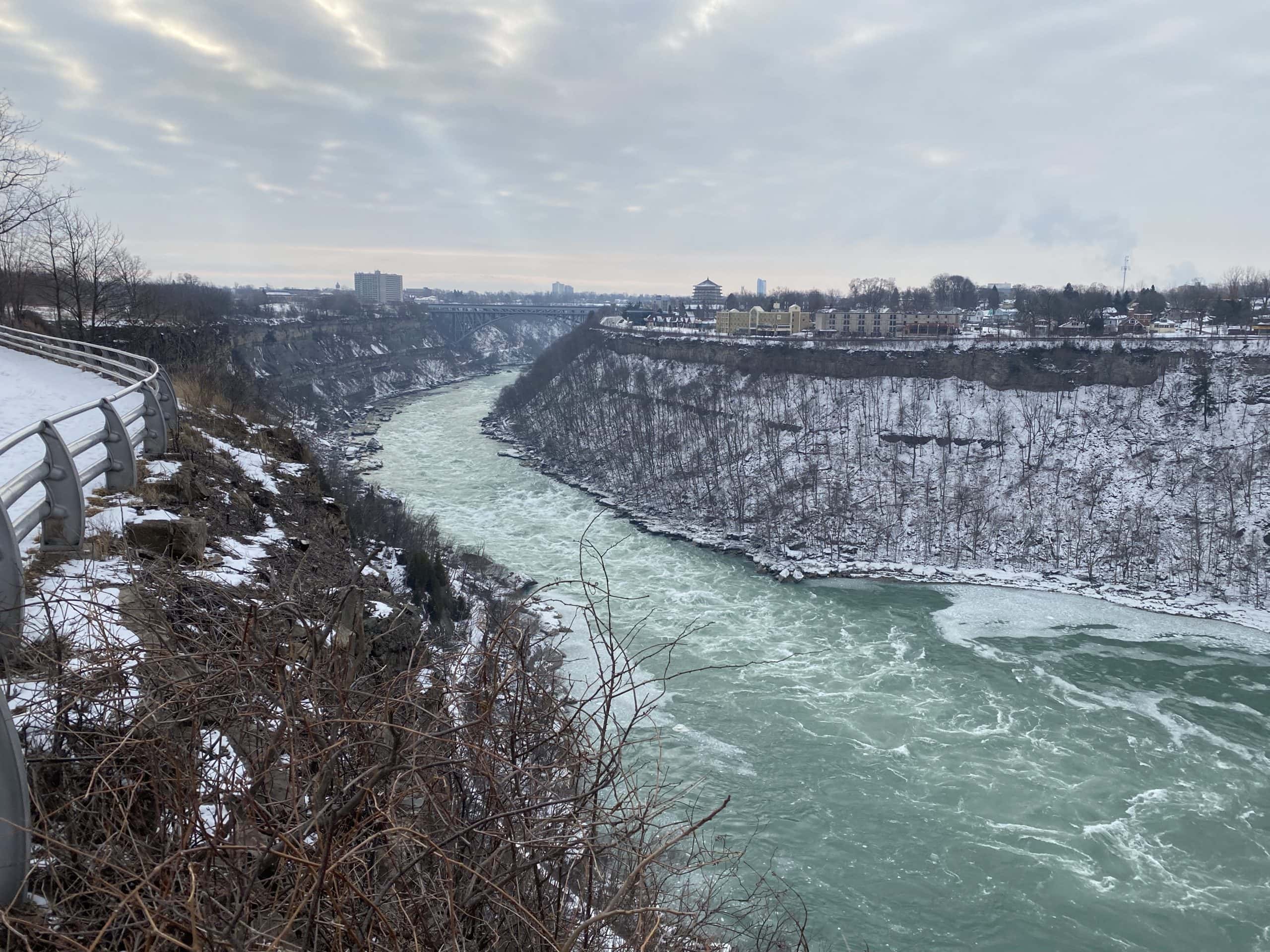
View of Whirlpool Bridge from Whirlpool State Park – good spot to see if ice bridge is forming below Niagara Falls

View of Niagara Falls via webcam from Niagara Falls, ON. Provides a decent view of ice build up.

View of Whirlpool Bridge from Whirlpool State Park – good spot to see if ice bridge is forming below Niagara Falls
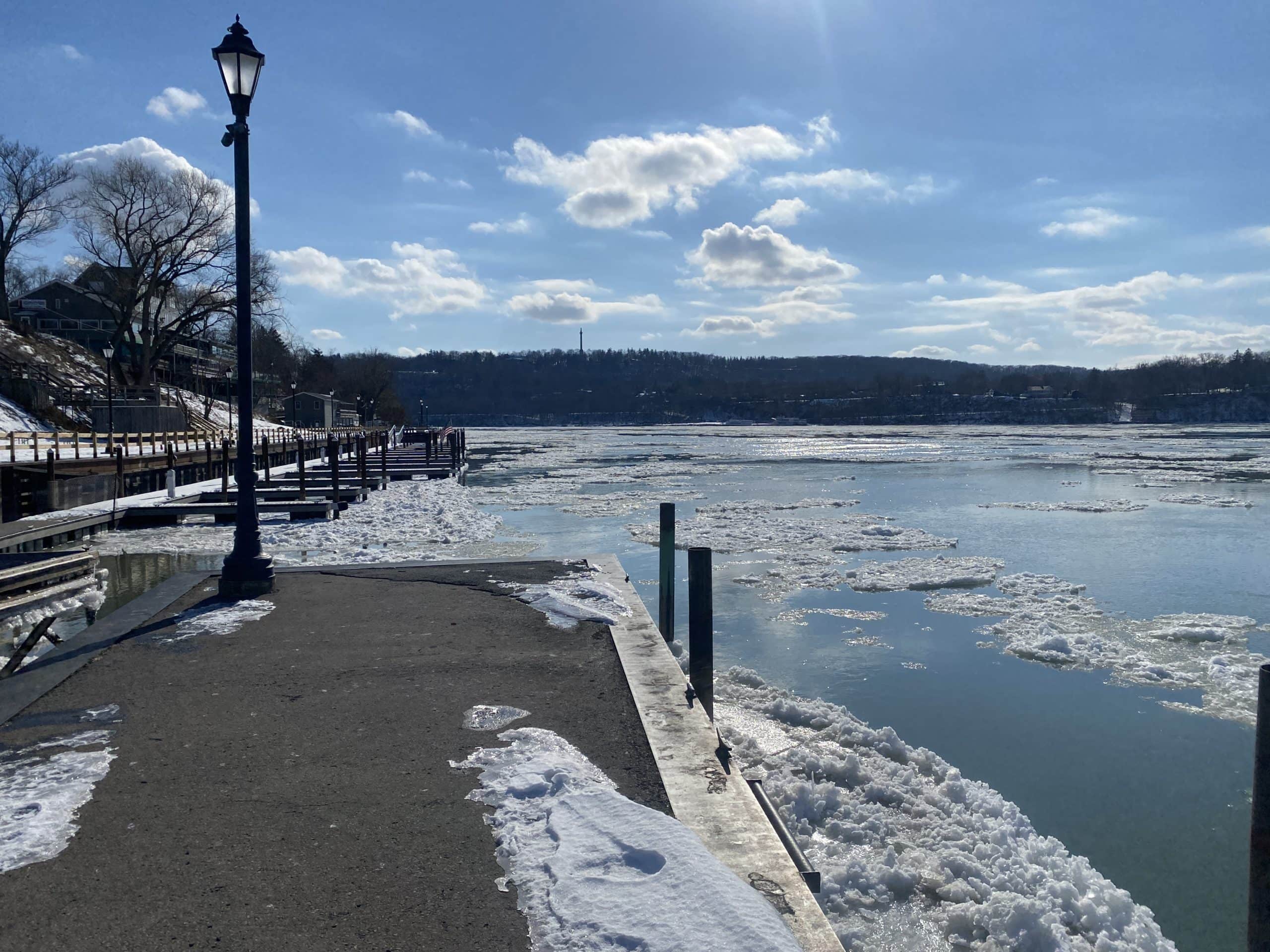
View of Lower Niagara from Lewiston, NY boat launch – taken on Thursday when the river was still full of ice. Tough to navigate!

View of Lower Niagara from Lewiston, NY boat launch – taken on Thursday when the river was still full of ice. Tough to navigate!
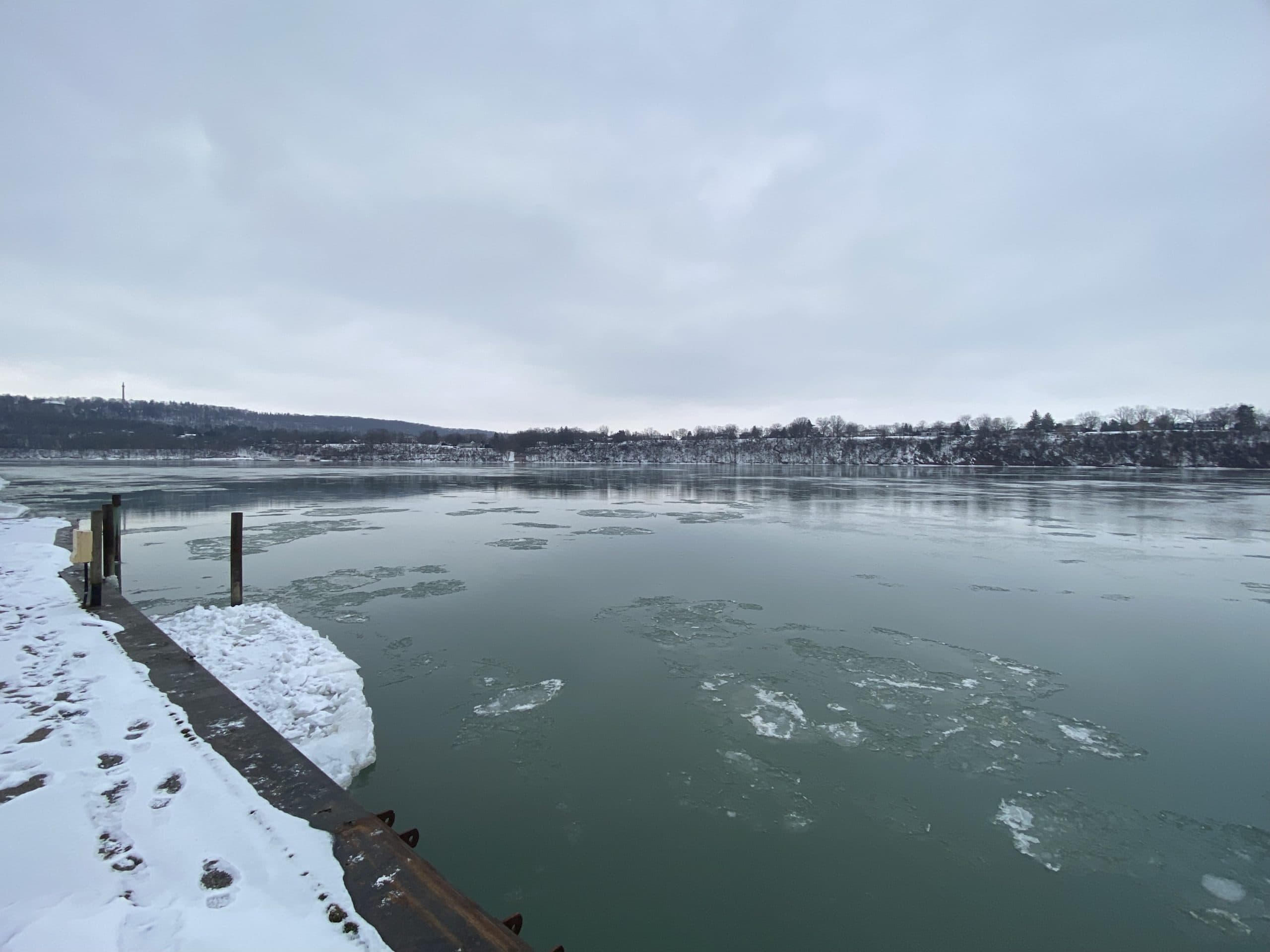
View of Lower Niagara from Lewiston, NY boat launch – taken on Friday – ice has cleared out – fishable but frigid (temp was 18).

View of Lower Niagara from Lewiston, NY boat launch – taken on Friday – ice has cleared out – fishable but frigid (temp was 18).
J.D. Outdoors Podcast
I had the pleasure of being a guest on the J.D. Outdoors Podcast. Although I am a voracious consumer of podcasts, I’ve never been a guest on one – it was a blast. I don’t listen to any fishing/outdoor recreation focused podcasts and I’m not sure why. Probably because I spend a ton of time fishing, thinking about fishing, and writing about fishing so when I consume content, I seek opportunities to think about different stuff. Still, talking with Jordan got me thinking about consuming more of that kind of content – especially supporting local anglers that are getting into this space.
Here are all the pertinent links:
J.D. Outdoors
YouTube: https://www.youtube.com/channel/UCJxTr_nhXnlioYxVqZakS3w?view_as=subscriber
Instagram: https://www.instagram.com/jd_outdoors1773/
Website: www.jdoutdoorslureco.com
Support this podcast: https://anchor.fm/jordan883/support
Looking Forward (15-21 Feb)
This upcoming week looks…hostile. It’s an awesome reminder of how good we had it last winter when temperatures and precipitation remained mild all winter. The meteorologists are predicting large amounts of snow and more freezing temperatures. Water color is excellent right now so if you find a window where what’s going on above water isn’t too harsh, fish will get caught. IF the forecast holds, this upcoming Wednesday looks promising as does the weekend.
If you live in the Great Lakes Region, shack nasties should be a serious concern right now – if not at the forefront, certainly on the radar. Yes, Covid-19 is still a very serious problem but unless you’ve been vaccinated, the concerns are the same as they’ve been for months. On the other hand, shack nasties are at highest risk of emergence in the middle of the winter – especially when the forecast predicts little else but frigid temperatures and snow. Get outside – breathe some fresh, crisp air, and absorb some sunlight. If you want to take it another step and experience something exciting this winter – give us a call.
Stay healthy my friends – mentally and physically,
Ryan
